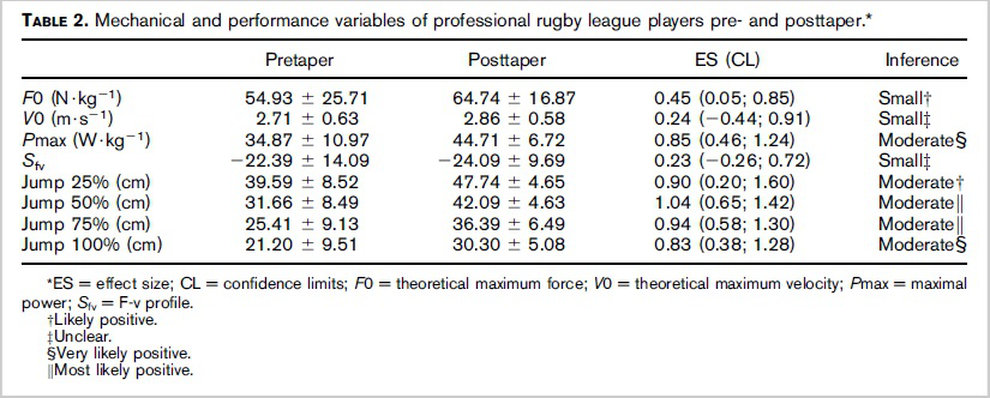One study has looked at the “overshoot phenomenon” in a professional team sport setting, but rather than observing changes in muscle fibre type, performance based variables were implemented [3].
Part 1 Part 2
Seven professional rugby league players from a National Rugby League Club, including 2 international players (age: 24 ± 3.6; height: 183.0 ± 6.1cm; weight: 99.0 ± 12.2kg) performed four months of preseason training consisting of resistance (weight) and field fitness and skills training. Both weight and field sessions were performed 3-4 times a week each averaging approx 60 minutes per session.
How was the taper structured?
In this study a step taper was implemented 21 days out from the start of the first round of the NRL season. A step taper is where training load is suddenly reduced rather than gradually. In this instance, the reduction of training load was manipulated by the reduction in training volume while intensity (how heavy you lift) remained high. During the taper, the subjects performed only one resistance training session each week while field sessions remained the same. A power-force-velocity profile was created for each athlete pre and post taper period using jump squats ranging from 0%-100% of bodyweight as external load.
What happened after the taper?
After the taper, likely small increase in force occurred while improvements in velocity were unclear. Maximal power and jump squats at varying external loads however showed likely to most likely moderate increases from pre to post taper.

Did an “overshoot” occur?
While muscle biopsies were not taken in this study, we can assume an “overshoot” did not occur as velocity capabilities changes were unclear. As explained earlier in the article, Type IIX muscle fibres have the fastest contraction time of all the muscle fibre types so more Type IIX muscle fibres would mean a greater velocity which did not occur.
So what does this all mean and what can we do with this information?
The first two studies [1, 2] covered sedentary subjects who produced greater force post detraining at greater velocities compared to both pre and post training. Also, these subjects produced greater power compared to pre and post training at greater angular velocities. In professional athletes after a 21 day taper, showed a positive change in maximal power and performance. These positive changes seem to be influenced by the increase in force capabilities rather than velocity, which goes against the study by Andersen et al., [1] explained in previous parts. One of the potential reasons for this was the taper length as the present study tapered for 21 days while Andersen et al., [1] detrained for 3 months. For a professional athlete (unless peaking for 1 event in the year like the Olympics), this would never be possible. Therefore, a short step taper implemented in this fashion leading into a season could be used to “peak” athletes for their first competition game.
Could this be useful for your sport you compete in?
From this data, we could speculate that the “overshoot” may only relate to high velocity unloaded movements (E.g. punching, sprinting, jumping) due to the increased Type IIX muscle fibres and greater velocity and power qualities. However, a short step taper can be implemented to potentially improve force and power capabilities. If you compete in a pure power sport (short sprint cycling, sprinting etc), this kind of step taper could be implemented to peak for a big competition after a long preparatory period. Potentially, enhancing your ability to display speed and power in your sport. For team sports, this kind of taper could be used during your last weeks of preseason or before a finals playoff series. However, it is hard to prescribe an “overshoot” to sports where you need to perform every week as there are many variables, we still don’t know when it comes to tapering and the “overshoot phenomenon.” For example, how long do these changes last? Do these changes affect any other areas of performance i.e sprint speed? What is the optimal taper length to illicit the greatest positive changes? Can we do this during the season to peak for playoffs? Hopefully these questions can be answered in future research.
